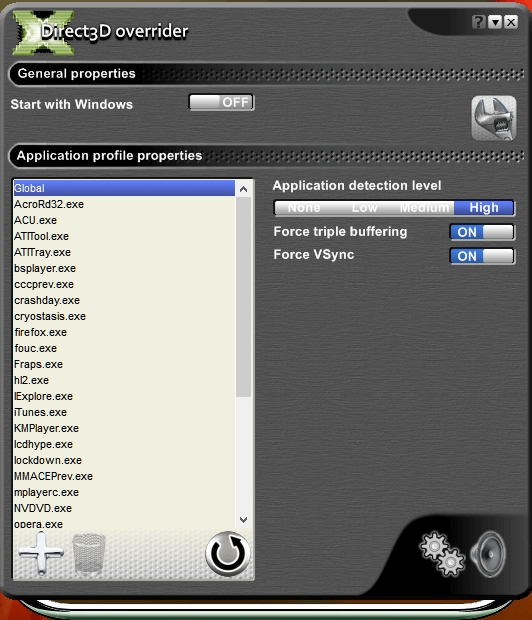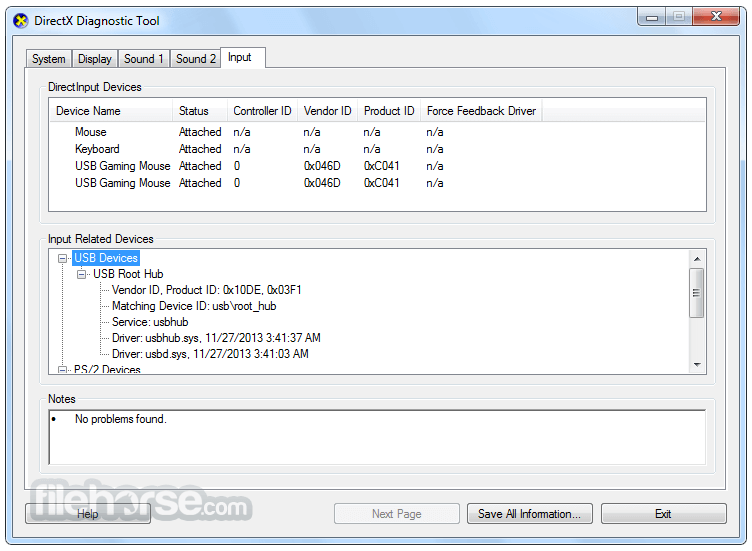
- #Direct3D Overrider Code When You
- #Direct3D Overrider Free From Hostr
- #Direct3D Overrider Upgrade To Current
Direct3D Overrider Free From Hostr
It has theDownload DirectX Redistributable June 2010 - Create an ideal platform for running and displaying applications rich in multimedia elements, such as full-color graphics, video, 3D animation, and audioThe Direct3D 12 adaptation for Windows 10, both in Win32 ( windows platform plugin) and in UWP ( winrt platform plugin), is shipped as a dynamically loaded plugin. Viking Ships At Sunrise (Magic Tree House Book 15) Ebook Rar. Overrider download direct3d overrider download windows 7 d3d overrider v2.4.zip dns. Download D3DOverrider DX11.rar fast and free from Hostr - Get free file hosting, and cloud sharing with Hostr. This was one of the Top Download Picks of The Washington Post and PC World.
Direct3D Overrider Upgrade To Current
DirectX 11.2 introduces a few new Direct3D features that could matter to games. In practice, this currently means Visual Studio 2015 and newer.Since Windows 8.1 will be offered as a free upgrade to current Windows 8 users, its effectively the Windows 7 user-base, thats being asked to take a hike. Building this plugin is enabled automatically, whenever the necessary D3D and DXGI develpoment files are present.
Note that this package does not modify the DirectX Runtime installed on your Windows OS in any way.This experimental adaptation is the first Qt Quick backend that focuses on a modern, lower-level graphics API in combination with a windowing system interface that's different from the traditional approaches used in combination with OpenGL.The Overrider works on many other games, but not in generations. MotivationThe Microsoft DirectX End-User Runtime installs a number of runtime libraries from the legacy DirectX SDK for some games that use D3DX9, D3DX10, D3DX11, XAudio 2.7, XInput 1.3, XACT, and/or Managed DirectX 1.1. However, it's never the default, meaning that the user or the application has to explicitly request it by setting the QT_QUICK_BACKEND environment variable to d3d12 or by calling QQuickWindow::setSceneGraphBackend(). This talk brings you up to speed with the API, offers tips on how to get your renderer up and running, presents key feature overviews, and The adaptation is available both in normal, OpenGL-enabled Qt builds, and also when Qt is configured with -no-opengl.
Direct3D Overrider Code When You
All the backend's own shaders (used by the built-in materials on which the Rectangle, Image, Text, and other QML types are built with) are compiled to D3D shader bytecode when you compile Qt. The backend doesn't heavily utilize threads yet, which means there are opportunities for further improvements in the future, for example to further optimize image loading.The D3D12 backend also introduces support for pre-compiled shaders. Consequently, there are fewer problems anticipated with drivers, operations like window resizes, and special events like graphics device loss caused by device resets or graphics driver updates.Performance-wise, the general expectation is a somewhat lower CPU usage compared to OpenGL, due to lower driver overhead, and a higher GPU utilization with less idle time wastage. I've tried several suggestions like changing compatibility settings, but it didn't help.This adaptation also allows better integration with Windows, as Direct3D is the primary vendor-supported solution. It should work, however, since it works for other people, and it has worked for me in the past.

QT_D3D_DEBUG enables the Direct3D debug layer.Note: The debug layer shouldn't be enabled in production use, since it can significantly impact performance (CPU load) due to increased API overhead. TroubleshootingIf you encounter issues, always set the QSG_INFO and QT_D3D_DEBUG environment variables to 1, to get debug and warning messages printed on the debug output. The adapters discovered are printed at startup when QSG_INFO or the qt.scenegraph.general logging category is enabled. To override this and use another graphics adapter or to force the use of the software rasterizer, set the QT_D3D_ADAPTER_INDEX environment variable to the index of the adapter.
This means that with the D3D12 backend, applications are expected to move their work from the main (GUI) thread out to worker threads, instead of expecting Qt to keep the GUI thread responsive and suitable for heavy, blocking operations.For more information see Qt Quick Scene Graph for details on render loops and Multithreading and DXGI regarding the issues with multithreading. Consequently, for the time being, the default is the single-threaded loop. However, due to conceptual limitations in DXGI, the windowing system interface, the threaded loop is prone to deadlocks when multiple QQuickWindow or QQuickView instances are shown. A threaded variant is also available, that you can request by setting the QSG_RENDER_LOOP environment variable to threaded.
However, the interpretation of the fragmentShader and vertexShader properties is different than with OpenGL.With D3D12, these strings can either be a URL for a local file, a file in the resource system, or an HLSL source string. Shader EffectsThe ShaderEffect QML type is fully functional with the D3D12 adaptation as well. The trade-offs between the various approaches are currently under research. The simpler renderer logic can also lead to lower CPU overhead in some cases. This is less of an issue, unlike OpenGL, because state changes don't present any problems in the first place.

This is necessary, because the mandatory flip model swapchain wouldn't support transparency otherwise.Therefore, it's important not to unneccessarily request an alpha channel. Semi-transparent WindowsWhen the alpha channel is enabled either via QQuickWindow::setDefaultAlphaBuffer() or by setting alphaBufferSize to a non-zero value in the window's QSurfaceFormat or in the global format managed by QSurfaceFormat::setDefaultFormat(), the D3D12 backend will create a swapchain for composition and go through DirectComposition. The backend automatically performs resolving into the non-multisample swapchain buffers after each frame. When the sample value is greater than 1, multisample offscreen render targets will be created with the specified sample count at the maximum supported quality level.
Everything else will trigger a QImage-based format conversion on the CPU first. Image FormatsWhen creating textures via C++ scene graph APIs like QQuickWindow::createTextureFromImage(), 32-bit formats won't involve any conversion, they'll map directly to the corresponding R8G8B8A8_UNORM or B8G8R8A8_UNORM format. Therefore, avoid enabling mipmapping for Non-Power-Of-Two (NPOT) images whenever possible. Textures of other size will work too, but this involves a QImage-based scaling on the CPU first. However, at the moment, this feature is experimental and only supports power-of-two images. MipmapsMipmap generation is supported and handled transparently to the applications via a built-in compute shader.
If you need to mix with QWidget-based user interfaces, use QWidget::createWindowContainer() to embed the native window of the QQuickWindow or QQuickView.Finally, rendering via QSGEngine and QSGAbstractRenderer is not feasible with the D3D12 adaptation at the moment. Therefore, only items that use the utility rectangle and image nodes are functional across all adaptations.QQuickWidget and its underlying OpenGL-based compositing architecture is not supported. Distance field-based text rendering is currently not implemented.The shader sources in the Qt Graphical Effects module have not been ported to any format other than the OpenGL 2.0 compatible one, meaning that the QML types provided by that module are currently not functional with the D3D12 backend.Texture atlases are currently not in use.The renderer may lack support for certain minor features, such as drawing points and lines with a width other than 1.Custom Qt Quick items using custom scene graph nodes can be problematic because materials are inherently tied to the graphics API.
Unlike their predecessors, these new classes are interfaces, and implementations are created via the QQuickWindow::createRectangleNode() and QQuickWindow::createImageNode() factory functions. These replace the now deprecated QSGSimpleRectNode and QSGSimpleTextureNode. They can also be used to check the level of shader support: shading language, compilation approach, and so on.When creating custom items, use the new QSGRectangleNode and QSGImageNode classes. It's not necessarily suitable for easy integration of all types of content, in particular true 3D, so it'll likely get complemented by an alternative to QQuickFramebufferObject in future releases.To perform runtime decisions based on the adaptation, use QSGRendererInterface from C++ and GraphicsInfo from QML. This approach doesn't rely on OpenGL contexts or API specifics like framebuffers, and allows exposing the graphics device and command buffer from the adaptation.


 0 kommentar(er)
0 kommentar(er)
